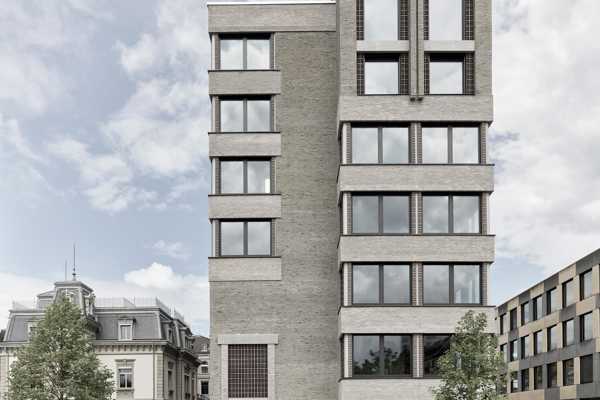Facing brickslinea 7035
Technical data sheets
- Color description
- The colour is light grey with nuances through and through and with beige accents..
- Manufacturing dimensions (L x W x H)
- ca. 248x117x38 mm (LxWxH)
- Quantity / m² with a traditional joint
- 77 (12 mm)
- Number / m² with a thin joint
- 90 (6 mm)
linea 7035
Light grey slim brick
This thin facing brick with subtle shading is produced using the Wasserstrich method. It also carries our Hand-Made label which guarantees a strong, natural nuance. This light grey unsanded variant from our linea series is ideal for accentuating clean linear designs in decorative brickwork.
case studie linea 7035

Block 18 Nieuw Zuid, Antwerp: Linea 7036 and 7035 with flush brushed joints help to realise the solid appearance of this special building
Striking residential block at Nieuw Zuid in Antwerp gives a nod to Italian palazzi
Nieuw Zuid in Antwerp is a beautiful and contemporary form of urban development. The site of a former freight train station has been transformed, creating a more pleasant and liveable city.

Seven-story modern structure in facing brick linea 7035 and 7036 complementing historical craftsmanship
Crucial role of facing brick serving aesthetic purpose and material harmony
The Villa Wiesental, a historic Gründerzeit villa built in 1878 by architect Daniel Oertli, stood as a testament to the craftsmanship and grandeur of its time. Commissioned by Konrad Menet Tanner, a wealthy textile merchant, the villa and its garden in St. Gallen, Switzerland, fell into disrepair after years of neglect. To ensure its preservation and reintegration into modern urban life, the owners proposed a thoughtful redevelopment plan. Central to this transformation was the construction of a seven-story modern structure adjacent to the villa, designed to complement its historical significance. At the heart of this architectural narrative was the selection and use of facing bricks, which not only served aesthetic purposes but also played a crucial role in the project's conceptual and material harmony.
Continue reading
References
How to Install ?
Preparation of the construction site
- Always order the full amount of bricks required for a specific site. In this way, the entire order can be made during one production run.
- Try to have the full order supplied at one time. If this creates several deliveries, always mix a number of packs from the previous delivery with a number of packs from the new delivery. This procedure is especially recommended in case of re-order or for an additional order.
- Take bricks diagonally across the pack.
- Draw and use bricks from at least five different packs.
- For setting out, use bricks from the delivery made to the site in question. Do not exclusively use the theoretical dimensions of the brick, or samples previously supplied, or different production run from that intended for the site.
- As soon as the bricks arrive on site, check delivery tickets and certificates against the specification and order. Also check that there are no visible inconsistencies with the order.
- Do not lay bricks in freezing weather or protect the ‘fresh’ masonry with insulating mats in order to avoid frost damage to the mortar.
- In the case of prolonged dry hot weather, lightly dampen the newly laid brickwork to stop the mortar drying and curing too quickly.
- Do not lay bricks in precipitation in order to prevent mortar from running on the wall.
Avoid Efflorescence
- During and after laying, protect the newly built brickwork for a height of at least 60 cm - but ensure there is airspace between the brick face and the waterproof covering.
- Provisionally install rainwater down pipes to avoid saturation of the newly laid brickwork
- Never lay bricks in driving rain conditions
























